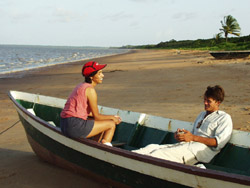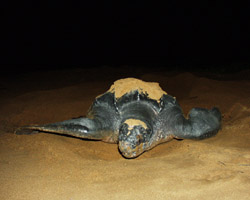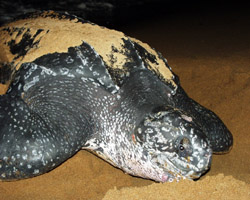| The Galibi Beaches
with STINASU and Biotopic
They have a saying in
Suriname "The man with the hammer is waiting for you". It refers to
how you put off you exhaustion until you can afford to feel its full
force. Yesterday the man with the sledgehammer came down hard on my
head. I thought I had Malaria, Leishmania and everything else that the
forest has to offer. Apparently I had spent the previous night, delirious
with fever, moaning in protest at all the diseases that I thought were
attacking my body. So I didn't make it to Devil's Island but spent my
day wandering around in daze from the Doctor to the Hospital laboratories
checking myself out. I am happy to report none of my fears were realised
and I only had exhaustion and a spot of blood poisoning from all the
bites I have been scratching!
So back to today... after two nights in French Guyana we were happy
to return to Suriname. The novelty of baguettes wears off after a couple
of days and we were spending money fast in the vastly over-priced province
of France. Over the last couple of weeks we have covered some quite
heavy stories, ones that show a less glowing side of this beautiful
country. No country is without its problems and internal divisions.
In travelling through Suriname our aim has been to offer all the remote
communities a window to the world, and to connect from the local to
the global level. Today I am happy to say that we once again begin a
positive story about this fascinating place.
It concerns the small Carib community of Galibi and the large Sea-Turtle
population that use the near-by beaches of Pruimenboom, Baboun Santi
and Spit as their nesting sites. Galibi is home to the people that call
themselves Calin'ia which literally translates as "people' or 'human
beings". They are a warrior people who were displaced from Curacao and
other nearby Caribbean Islands by the arrival of the Spanish Conquistadors
in the late 15th Century. They landed and displaced the Arawaks who
were living here at that time who subsequently moved inland.
The situation on which we are here to focus concerns the Caribs and
the Turtles. For centuries the Caribs have taken a harvest of the Turtle
eggs as a source of food for the community. In recent decades, international
conservation groups have been trying to protect the nesting grounds.
Over the years, after mistakes and miscommunication the conservationists
and the Carib Community have found a way of working together to both
protect the turtles and to help the local community. At first outsiders
came in and, excluding the Caribs, tried to fence off the breeding grounds.
Not surprisingly the villagers would not co-operate with the conservationists
as they were not included in the projects... worse they were seen as
the problem rather than as part of the solution. The community-based
approach being used here is becoming common practice in Africa and other
parts of the world. It acknowledges that the people who have traditionally
used the (globally scarce but locally plentiful) natural resources of
an area must be included in the centre of efforts to preserve these
resources.
So here in Galibi and in the nearby beaches we will be once again looking
at the work of STINASU. They together with the WWF and a small group
of researchers called Bio-topic are now working with the Galibi villagers
to help protect this; the largest breeding ground in the world for the
endangered species of Sea Turtle that come here to breed. Here the giant
Leatherback (up to 2 meters in length), the Green Turtle, the Hawksbill
and the Warana emerge from the sea at night and clamber up the short
stretch of sandy beach, their heavy bodies unaccustomed to moving with
the full force of gravity. They dig a hole and lay their eggs in a nest
under the sand. Their life cycle is an astounding one. After hatching
and the successful negotiation of the most dangerous few minutes of
their life when they make a dash for the sea under the beady eye of
the circling vultures; they disappear off to sea. They go all over the
place and have been tracked down to the Antarctic and up to the waters
off Alaska, and have been recorded to have dived over 2km deep into
the ocean's depths. Perhaps most amazing is the fact that after the
first 17 years of their life they find their way back to the same breeding
grounds that they themselves were born on. I guess they are working
on the principle well used in nature: "If it worked for me then why
not my children".
So tonight we arrived at the STINASU lodge on Baboun Santi. We met up
with Karin Lachmising, the Marketing manager of the Suriname Tourism
Foundation and she has filled us in on the broader picture of tourism
here and the plans for future developments. What is great to hear is
how conscious she is of keeping a balance between tourism and the needs
of the local communities and the environment to which the tourists go
visiting. Likewise when we interviewed Reggie the manager of the STINASU
lodge he made it crystal clear. "First we are here to protect the turtles,
then come the tourists. Because we manage both, if the tourism becomes
too much then we can simply reduce the number of tourists"... a good
set of priorities.
It will be great to sleep tonight with the sound of the ocean waves
lapping at the shore.... Maybe I'll dream it's still the rapids! But
first we're off Turtle spotting in the moonlight.
|

Last Remains

Galibi - A Beach at Last!

Chatting to Karin Lachmising

A Late Night Glimpse!

Leatherback Turtle
|










